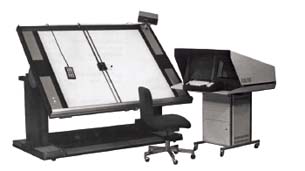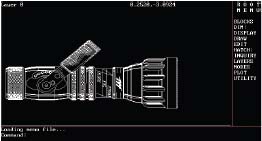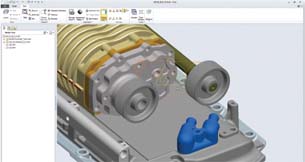Latest News
December 1, 2010
While they may seem new to some, many of the computer-aided design programs we use today have been around for more than a decade, and virtually all trace their lineage to work begun more than 50 years ago.
Modern engineering design and drafting can be traced back to the development of descriptive geometry in the 16th and 17th centuries. Drafting methods improved with the introduction of drafting machines, but the creation of engineering drawings changed very little until after World War II.
During the war, considerable work was done in the development of real-time computing, particularly at MIT, and by the 1950s there were dozens of people working on numerical control of machine tools and automating engineering design. But it’s the work of two people in particular—Patrick Hanratty and Ivan Sutherland—who are largely credited with setting the stage for what we know today as CAD.

The Fathers of CAD
Hanratty is widely credited as “the Father of CADD/CAM.” In 1957, while working at GE, he developed PRONTO (Program for Numerical Tooling Operations), the first commercial CNC programming system. Five years later, Sutherland presented his Ph.D. thesis at MIT titled “Sketchpad, A Man-Machine Graphical Communication System.” Among its features, the first graphical user interface, using a light pen to manipulate objects displayed on a CRT.
The 1960s brought other developments, including the first digitizer (from Auto-trol) and DAC-1, the first production interactive graphics manufacturing system. By the end of the decade, a number of companies were founded to commercialize their fledgling CAD programs, including SDRC, Evans & Sutherland, Applicon, Computervision, and M&S Computing.
By the 1970s, research had moved from 2D to 3D. Major milestones included the work of Ken Versprille, whose invention of NURBS for his Ph.D. thesis formed the basis of modern 3D curve and surface modeling, and the development by Alan Grayer, Charles Lang, and Ian Braid of the PADL (Part and Assembly Description Language) solid modeler.
With the emergence of UNIX workstations in the early ’80s, commercial CAD systems like CATIA and others began showing up in aerospace, automotive, and other industries. But it was the introduction of the first IBM PC in 1981 that set the stage for the large-scale adoption of CAD. The following year, a group of programmers formed Autodesk, and in 1983 released AutoCAD, the first significant CAD program for the IBM PC.

The CAD Revolution
AutoCAD marked a huge milestone in the evolution of CAD. Its developers set out to deliver 80% of the functionality of the other CAD programs of the day, for 20% of their cost. From then on, increasingly advanced drafting and engineering functionality became more affordable. But it was still largely 2D.
That changed in 1987 with the release of Pro/ENGINEER, a CAD program based on solid geometry and feature-based parametric techniques for defining parts and assemblies. It ran on UNIX workstations—PCs of the time were simply not powerful enough—but it was a game changer. The later years of the decade saw the release of several 3D modeling kernels, most notably ACIS and Parasolids, which would form the basis for other history-based parametric CAD programs.
By the 1990s, the PC was capable of the computations required by 3D CAD. In 1995, when the first issue of Desktop Engineering was published, SolidWorks was released. It was the first significant solid modeler for Windows. This was followed by Solid Edge, Inventor, and others. The decade also saw many of the original CAD developers from the 1960s acquired by newer companies and a consolidation of the industry into four main players—Autodesk, Dassault Systèmes (which acquired SolidWorks in 1997), PTC, and UGS (now Siemens PLM)—along with a host of smaller developers.
CAD Today, CAD Tomorrow
The modern CAD era has been marked by improvements in modeling, incorporation of analysis, and management of the products we create, from conception and engineering to manufacturing, sales, and maintenance (what has become known as PLM, product lifecycle management). But what of the world of tomorrow?
“Engineers and designers are being asked to create more, faster, and with higher quality,” says Bill McClure, vice president of product development at Siemens PLM. He notes that CAD really hasn’t changed much beyond adding more features and updating the user interface. “We need a new way of working to keep up with demands,” he says. Siemens’ synchronous technology “was developed to address this trend, as it combines the precision and control of feature-based design with the speed and flexibility of explicit modeling. The result is designers spend less time planning a model’s construction, less time waiting for design changes, and less time remodeling imported or customer data for new uses.”
PTC is taking a similar approach with the recent announcement of its Project Lightning, which was revealed as Creo in October.
Brian Shepherd, executive vice president of product development at PTC, described Creo as “PTC’s answer to this question about the next 20 years of CAD,” and claims it will solve ease-of-use, interoperability, and assembly management problems with CAD.

“Almost all CAD revenue has been through parametric modelers, following the paradigm that Pro/E invented,” he says. But parametric modeling is an abstract approach for creating geometry. “You build a recipe and then the recipe creates the geometry. Direct modeling is much easier for people to understand,” says Shepherd. “We think the right answer is a blend of parametrics and explicit modeling.”
Creo promises to do just that by releasing a series of apps that allow users to design in 2D, 3D direct or 3D parametric modes, with the data updated and reusable in any of those modes. It also offers different user interfaces for different kinds of users, and promises to allow users to incorporate data from any CAD system.
“The feature-based paradigm will not get us to the next level,” says Mike Payne. “Something like direct modeling is needed to attract a larger audience to CAD.” And Payne should know. Over the years, he has been vice president of development at PTC, was a co-founder of SolidWorks, CTO of Dassault Systèmes, CEO of Spatial Corp., and co-founder and former CEO of SpaceClaim.
Robert “Buzz” Kross, senior vice president of the Manufacturing Industry Group at Autodesk, sees three technologies that will have the greatest impact on the future of CAD: “new, very friendly, very interactive interfaces, embedded simulation, and the cloud.” The first, he explained, will attract new users and will support faster design iterations. Embedded simulations will enable users to analyze design data as they model, so that “designers will immediately know the result of any change before they commit to it.” And the cloud, “will deliver immense compute power to everyone’s device, even mobile devices.”
The Mac and Low-Cost CAD
With Autodesk’s recent release of a native Macintosh version of AutoCAD 2011, the Mac might be poised to gain market share as a technical workstation. Not surprisingly, Kross is enthusiastic. “Looking at the demographics of users, I see lots of Mac growth.” But others are more cautious.
“Microsoft Windows still maintains over 90% market share of the client operating systems,” says McClure. “Until this changes, native versions of CAD programs on other platforms will be interesting for some users, but will not represent a significant market share opportunity.” He notes that the cost to develop and support multiple hardware platforms is daunting.
“There’s no economy of scale in developing multi-platform applications,” says Alibre Chairman and CEO, Paul Grayson.
Will low-cost CAD software take a bite out of the big companies’ market share? It depends on who you ask. Grayson says it’s already happening, while Payne notes that was what AutoCAD did in ’83. “Once AutoCAD could do everything that the expensive systems could do, the game was over,” he says. “The volume guy wins. Everyone knows that except big CAD companies.”
But it appears that the “big” CAD companies have learned something. Shepherd says PTC’s Creo will feature “role-based apps,” with some of the company’s new tools being “very low cost. Maybe free.” But then he hedged, noting that the company needs to be able to fund innovation for its high-end users. For them, he says, “I think we’re already at the price point that makes sense.”
Even Mike Riddle, founder of Evolution Computing and a programmer instrumental in the earliest release of AutoCAD, doesn’t see much viability in low-cost CAD. “When businesses start spending money on things like CAD after a recession, they start with low-cost CAD for the non-critical seats, but weaknesses in implementation and interoperability eventually drive businesses back to ‘full-boat’ systems—not for capability but for reliability.”
Other Technologies to Watch
Utilizing the increasing number of CPU cores is essential to future implementations, while utilizing GPU cores will likely remain specialized. “Software that doesn’t become massively multi-core in implementation will be left behind as our models become larger,” notes Riddle. Yet McClure was quick to point out that “overall CAD performance is not limited by the CPU,” and others concurred. Multi-threading provides great benefits for things like analysis and rendering, but most people want to see improved speed in geometry regeneration, which is fundamentally a serial process.
What about touch-based and gesture based interfaces? “Gestures will become more and more prevalent,” says Kross. “Specific operations like pan, zoom, and rotate are particularly benefitted from touch-based interactions.”
Kross sees touch as becoming mainstream, whereas McClure sees these technologies as “an excellent interface for handheld and tablet devices. However, it is not clear that the touch-based interface will have a big impact on engineering authoring applications.” He notes that CAD generally requires high levels of precision and “touch-based gesturing has not proven to allow such precision.”
Both McClure and Shepherd questioned the viability of working at an engineering workstation for long hours with arms extended to work at a touch-based display.
So other than these emerging technologies, has CAD become mature? “There is no such thing as a lack of ability to innovate for any design tool,” says Riddle. “A mature technology is another way of saying that the current approach has been fully developed.”
Are there any geometric forms we still can’t model? “I think we can model virtually all shapes, but it is still way too hard,” says Kross. And according to Payne, “It’s not so much a question of whether we can or cannot model everything. It is more a question of whether all users can or cannot model everything. The systems of today require an expert to even remember how he built the model. We must put the smarts in the software, instead of needing people to be Top Guns.”
As for what waits on the horizon, perhaps the wildest speculation came from Grayson: “Direct human to machine interfaces. Imagine searching Google by thinking of a search phrase and having the answer appear in your short term memory, or manipulating 3D objects in your brain while a computer manipulates virtual representations of those objects on its display.”
Is that something we’ll find in CAD systems of the future? If we do, remember that you read it first here.
For More Info
Alibre
Autodesk
DS SolidWorks
Evolution Computing
PTC
Siemens PLM
SpaceClaim
Spatial Corp.
Subscribe to our FREE magazine, FREE email newsletters or both!
Latest News
About the Author
David Cohn is a consultant and technical writer based in Bellingham, WA, and has been benchmarking PCs since 1984. He is a Contributing Editor to Digital Engineering, the former senior content manager at 4D Technologies, and the author of more than a dozen books. Email at [email protected] or visit his website at www.dscohn.com.
Follow DE





